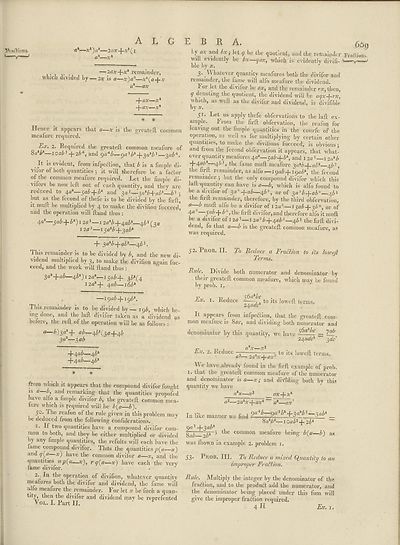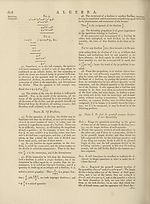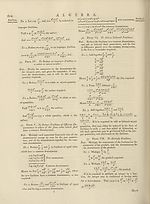Encyclopaedia Britannica, or, a Dictionary of arts, sciences, and miscellaneous literature : enlarged and improved. Illustrated with nearly six hundred engravings > Volume 1, A-AME
(653) Page 609
Download files
Complete book:
Individual page:
Thumbnail gallery: Grid view | List view

JV actions.
ALGEBRA.
-x'^a1— 2ciX-\- X* (I
a*-—X*
6O9
which divided by.
— lax-^-x1 remainder,
■2% is a—x)^—x'^a-^x
a*—ax
-\-ax—x*
-\-ax—x*
-x is the greateft common
Hence it appears that a-
meai’urc required.
-Ex. 2. Required the greateft common meafure of
Sa'b1—ioab'-]-2bA, and b1-\-2>a1b' yib*.
at is evident, from infpeftion, that $ is a fimple di-
vifor of both quantities 5 it will therefore he a fador
of the common meafure required. Let the fimple di-
vifors be now left out of each quantity, and they are
reduced to 4a*—5^ + ^ and 3a'—yfb+ab'—b' 5
hut as the lecond of thefe is to be divided by the firft,
it mull be multiplied by 4 to make the diviiion fuccecd’
and the operation will Rand thus :
40*—5«£ + £*) I 2« 5 — I 2a*^-j-4flZ>*—4^* (3a
12a3—i^b+zab*
by a.v and bx ; let q be the quotient, and the remainder Fra&ions
\mII evidently be bx—winch is evidently divifi-
ble by x.
3. \\ hatever quantity meafures both the divifor and
remainder, the lame will alfo meafure the dividend.
lor let the divilor be ax, and the remainder rx, then,
q denoting the quotient, the dividend will be aqx-\-rx,
u inch, as well as the divifor and dividend, is divifible
by x.
51. Let^ us apply thefe obfervations to the hill ex¬
ample. From the firft obfervation, the reafon for
leaving out the fimple quantities in the courfe of the
opeiation, as well as for multiplying by certain other
quantities, to make the divifions fucceed, is obvious j
and from the fecond obfervation it appears, that what¬
ever quantity meafures ^—^ab -{-£*, and 1203 —12alb
+ —4^3, the fame muft meafure 3a*b-\-ali ^bK
the firft remainder, as alfo —19^4-19^*, the fecond
remainder 5 but the only compound divifor which this
lalt quantity can have is a—b, which is alfo found to
be a diyilor ol 3a1 ^-ab—qb'z, or of 3a~b~\-ab’z—4&3
the firft remainder, therefore, by the third obfervation,
a—b muft alfo be a divifor of 1202—\$ab-\-, or of
4« - —yib -f Z> -, the firft divifor, and therefore alfo it muft
be a diyifor of 12fl3—12a2 -}-4#£2 —4^3 the firft divi¬
dend, fo that a—b is the greateft common meafure, as
was required.
-f- 3axb-\-ab%—4^3.
'I'his remainder is to be divided Iiy b, and the new di¬
vidend multiplied by 3, to make the divifion again fuc¬
ceed, and the work Avill Hand thus :
3ax-\-ab—Atb1)i2(i1—isab-\- 3^(4
12fll + 4ub—i6bl
—19«^4-19^1.
This remainder is to be divided by — 19^ w],ich be¬
ing done, and the laft divifor taken as a dividend as
before, the reft of the operation will be as follows :
3al—3 ab
4-40^—4^*
-\-4ab—4^*
. * *
from Avhich it appears that the compound divifor fought
a b, and remarking that the quantities propofed
have alio a iimple divifor b, the greateft common mea¬
sure which is Required Avill be b(a—b).
30. ilie reaion of tlie rule given in this problem may
ne deduced from the lolloAving confiderations.
1. II two quantities have a compound divifor com¬
mon to both, and they be either multiplied or divided
by any fimple quantities, the refults will each have the
iame compound divifor. Tints the quantities y»(«—x)
and q(a .v) have the common divifor a—x, and the
quantities 7ip(a—x), r q{a—x') have each the very
lame divifor.
2. In the operation of divifion, whatever quantity
meal ures both the divifor and dividend, the fame will
alfo meafure the remainder. For let x he fuch a quan¬
tity, then the divifor and dividend may be reprefented
Vol. I. Part II. * :
52* I)HOB. II. To Reduce a Traci ion to its lowejl
Terms.
Rule.' Divide both numerator and denominator by
then greateft common meaiure, which may be found
by prob. 1.
Ex. 1. Reduce —to its loweft terms.
2i\adc
It appears from infpe&ion, that the greateft com¬
mon meaiure is Sue, and dividing both numerator and
denominator by this quantity, we have
2i[acicl 3dc
Ex. 2. Reduce — a —- to its loweft terms.
IVe have.already found in the firft example of prob.
1. that the greateft common meafure of the numerator
and denominator is a—x; and dividing both bv this
quantity we have
a*x—a3 ax 4- x*
a*—2a'1x-\-axz a*—ax'
In like manner we find —
80*^* IO<7^34-2^4
9«3 4-3«^
SnZ1 t lC common meafure being b^a—b) as
was fliowm in example 2. problem 1.
53. Prob. III. To Reduce a mixed Quantity to an
improper Tra&ion.
Rule. Multiply the integer by the denominator of the
fraction, and to the product add the numerator, and
the denominator being placed under this ium will
give the improper fraction required.
4H
Ex. 1,
ALGEBRA.
-x'^a1— 2ciX-\- X* (I
a*-—X*
6O9
which divided by.
— lax-^-x1 remainder,
■2% is a—x)^—x'^a-^x
a*—ax
-\-ax—x*
-\-ax—x*
-x is the greateft common
Hence it appears that a-
meai’urc required.
-Ex. 2. Required the greateft common meafure of
Sa'b1—ioab'-]-2bA, and b1-\-2>a1b' yib*.
at is evident, from infpeftion, that $ is a fimple di-
vifor of both quantities 5 it will therefore he a fador
of the common meafure required. Let the fimple di-
vifors be now left out of each quantity, and they are
reduced to 4a*—5^ + ^ and 3a'—yfb+ab'—b' 5
hut as the lecond of thefe is to be divided by the firft,
it mull be multiplied by 4 to make the diviiion fuccecd’
and the operation will Rand thus :
40*—5«£ + £*) I 2« 5 — I 2a*^-j-4flZ>*—4^* (3a
12a3—i^b+zab*
by a.v and bx ; let q be the quotient, and the remainder Fra&ions
\mII evidently be bx—winch is evidently divifi-
ble by x.
3. \\ hatever quantity meafures both the divifor and
remainder, the lame will alfo meafure the dividend.
lor let the divilor be ax, and the remainder rx, then,
q denoting the quotient, the dividend will be aqx-\-rx,
u inch, as well as the divifor and dividend, is divifible
by x.
51. Let^ us apply thefe obfervations to the hill ex¬
ample. From the firft obfervation, the reafon for
leaving out the fimple quantities in the courfe of the
opeiation, as well as for multiplying by certain other
quantities, to make the divifions fucceed, is obvious j
and from the fecond obfervation it appears, that what¬
ever quantity meafures ^—^ab -{-£*, and 1203 —12alb
+ —4^3, the fame muft meafure 3a*b-\-ali ^bK
the firft remainder, as alfo —19^4-19^*, the fecond
remainder 5 but the only compound divifor which this
lalt quantity can have is a—b, which is alfo found to
be a diyilor ol 3a1 ^-ab—qb'z, or of 3a~b~\-ab’z—4&3
the firft remainder, therefore, by the third obfervation,
a—b muft alfo be a divifor of 1202—\$ab-\-, or of
4« - —yib -f Z> -, the firft divifor, and therefore alfo it muft
be a diyifor of 12fl3—12a2 -}-4#£2 —4^3 the firft divi¬
dend, fo that a—b is the greateft common meafure, as
was required.
-f- 3axb-\-ab%—4^3.
'I'his remainder is to be divided Iiy b, and the new di¬
vidend multiplied by 3, to make the divifion again fuc¬
ceed, and the work Avill Hand thus :
3ax-\-ab—Atb1)i2(i1—isab-\- 3^(4
12fll + 4ub—i6bl
—19«^4-19^1.
This remainder is to be divided by — 19^ w],ich be¬
ing done, and the laft divifor taken as a dividend as
before, the reft of the operation will be as follows :
3al—3 ab
4-40^—4^*
-\-4ab—4^*
. * *
from Avhich it appears that the compound divifor fought
a b, and remarking that the quantities propofed
have alio a iimple divifor b, the greateft common mea¬
sure which is Required Avill be b(a—b).
30. ilie reaion of tlie rule given in this problem may
ne deduced from the lolloAving confiderations.
1. II two quantities have a compound divifor com¬
mon to both, and they be either multiplied or divided
by any fimple quantities, the refults will each have the
iame compound divifor. Tints the quantities y»(«—x)
and q(a .v) have the common divifor a—x, and the
quantities 7ip(a—x), r q{a—x') have each the very
lame divifor.
2. In the operation of divifion, whatever quantity
meal ures both the divifor and dividend, the fame will
alfo meafure the remainder. For let x he fuch a quan¬
tity, then the divifor and dividend may be reprefented
Vol. I. Part II. * :
52* I)HOB. II. To Reduce a Traci ion to its lowejl
Terms.
Rule.' Divide both numerator and denominator by
then greateft common meaiure, which may be found
by prob. 1.
Ex. 1. Reduce —to its loweft terms.
2i\adc
It appears from infpe&ion, that the greateft com¬
mon meaiure is Sue, and dividing both numerator and
denominator by this quantity, we have
2i[acicl 3dc
Ex. 2. Reduce — a —- to its loweft terms.
IVe have.already found in the firft example of prob.
1. that the greateft common meafure of the numerator
and denominator is a—x; and dividing both bv this
quantity we have
a*x—a3 ax 4- x*
a*—2a'1x-\-axz a*—ax'
In like manner we find —
80*^* IO<7^34-2^4
9«3 4-3«^
SnZ1 t lC common meafure being b^a—b) as
was fliowm in example 2. problem 1.
53. Prob. III. To Reduce a mixed Quantity to an
improper Tra&ion.
Rule. Multiply the integer by the denominator of the
fraction, and to the product add the numerator, and
the denominator being placed under this ium will
give the improper fraction required.
4H
Ex. 1,
Set display mode to:
![]() Universal Viewer |
Universal Viewer | ![]() Mirador |
Large image | Transcription
Mirador |
Large image | Transcription
Images and transcriptions on this page, including medium image downloads, may be used under the Creative Commons Attribution 4.0 International Licence unless otherwise stated. ![]()
| Permanent URL | https://digital.nls.uk/193140474 |
|---|
| Attribution and copyright: |
|
|---|
| Description | Ten editions of 'Encyclopaedia Britannica', issued from 1768-1903, in 231 volumes. Originally issued in 100 weekly parts (3 volumes) between 1768 and 1771 by publishers: Colin Macfarquhar and Andrew Bell (Edinburgh); editor: William Smellie: engraver: Andrew Bell. Expanded editions in the 19th century featured more volumes and contributions from leading experts in their fields. Managed and published in Edinburgh up to the 9th edition (25 volumes, from 1875-1889); the 10th edition (1902-1903) re-issued the 9th edition, with 11 supplementary volumes. |
|---|---|
| Additional NLS resources: |
|

